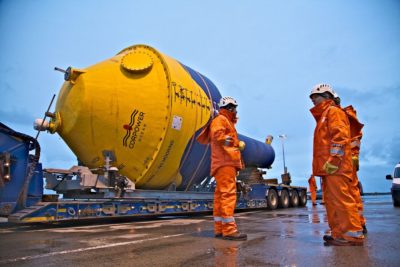THE seas off the Scottish Islands of the Orkney’s are not known for being the most hospitable in winter, but for researchers they are perfect when it comes to testing the capabilities of wave and tidal energy systems.
Tidal flows and wave heights are just about perfect.
That’s why, laid into the seabed just off the shores of the islands are large concrete foundations where ocean energy system developers can come and tether their test rigs and see how much electricity they can generate out of the waves and tides.
This test areas are run by EMEC, the European Marine Energy Centre. It has seen quite a number of potential systems bring in their engineering projects and subject them to the Scottish elements over the last 15 years,
The latest one to go there is CorPower Ocean, a Swedish engineering start-up that has begun to create a buzz with its solution. CorPower is based in the bowels of a huge academic engineering facility in the Royal Institute of Technology in Stockholm.
To find its offices your really do need to be shown where they are, one gets the feeling the skilled engineers working at CorPower are not used to visitors, and really don’t mind. They are too busy doing things.
CorPower CEO Patrik Möller is a machine orientated entrepreneur and system architect, and no stranger to the start-up world. He understands the need for a structured approach to securing funding, linking it to the development stages and having industry on board for what is an ongoing intensive, though impressive development cycle. He also understands that a start-up with a solution based in the oceans will take time to come to fruition.
The current testing in Orkney islands will help Moller and his team work with investors and partners in moving the project to the next level and commercialisation by 2022. The company started back in 2009. These tests are on a half scale system, which is still nonetheless impressive in size.
It is also the only test model of this size the company has. Prior to being loaded onto a huge flatbed and taken across Sweden to Gothenburg and then shipped on a freight ferry to Scotland, the test unit had been put through its paces in the engineering lab in Stockholm.
“We really needed to see if there were any flaws that could cause any trouble if they appeared in the water,” says Möller, adding that the full load tests were certainly noisy, but ultimately successful. “We were able to feed electricity back into the Swedish power grid.”
Möller is convinced that the CorPower system has the capability to succeed where a large number of other projects have stalled. The company’s calculations, which have impressed its backers, suggest that the system,
basically, a huge buoy free floating up and down a rod to create resonant energy, has more potential to harness energy than any other system that has been tried before.
CorPower’s tests in Orkney will lead to more funding and what will be stage four of a five stage process; a full-scale test. The fifth stage will be an array test and that’s where Möller thinks things can get interesting.
Basically, CorPower sees two markets for the invention.
On the one hand an array of buoys can be aligned to an offshore windfarm to create a much more constant energy supply- one which will help alleviate one of the key problems of offshore energy-energy balance. If a collection of different renewable energy sources can be coupled together through an energy island or other energy collection point, then there is a better chance for this being part of a country’s base energy needs rather than just creating energy when the weather conditions are right and thus leading to huge and costly energy storage demands.
The other use is no less interesting. With the development of battery and electric propulsion in shipping and deep-water aquaculture requirements, there could well be a need for offshore power generation and recharging stations, Möller sees this as a micro-grid set up with big potential.
First however CorPower needs to use the current stage three tests in Orkney to convince investors of the future of ocean renewables, and CorPower, which has its sights set on full commercialisation in four years’ time.
Hear about CorPowers plans, and how ocean renewable energy may be coming of age with new regulations and societal demands during Opening Oceans Conference in Copenhagen, May 2nd and 3rd
































